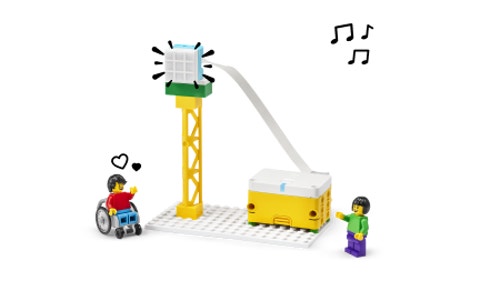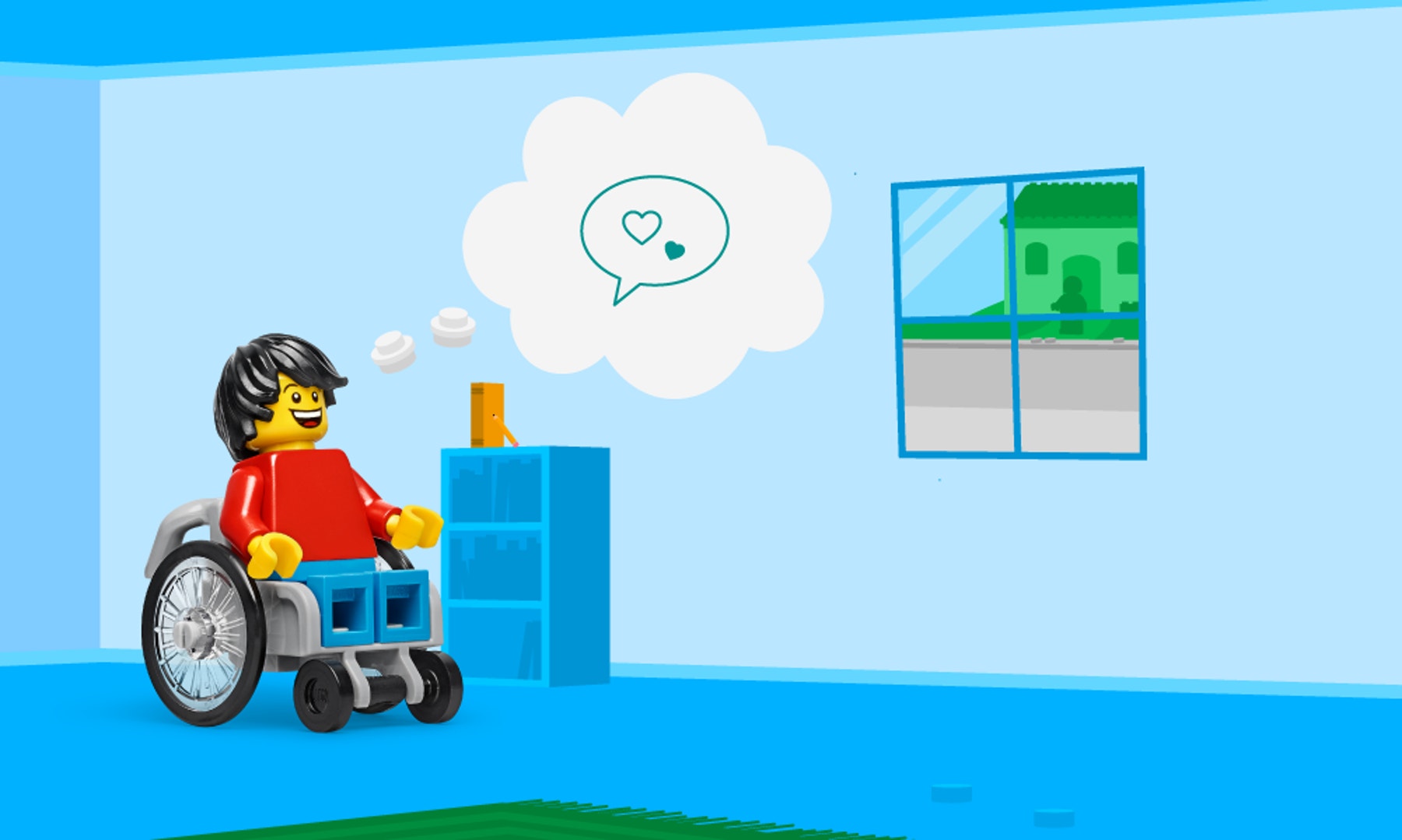Communicate with Light and Sound
Daniel lives across the street from Sofie. What can he build to send messages to her?

Prepare
(NOTE: This lesson contains a Part A and a Part B. Both are important to access the full learning of the standard. If time is limited, review both parts to choose elements that meet your students’ needs.)
In this lesson, the key learning is to design and build a messaging device that uses light or sound to communicate over a distance. Students will design their own light or sound message codes and then create a model device as a fun, hands-on way to test those codes. The lesson provides both code suggestions and building/programming examples for inspiration. Encourage students to design their own message codes and devices.
- Science Background - Communicate with Light or Sound: Long-distance communication solutions are as old as human history.
- Ancient cultures used drums, runners with verbal messages, couriers carrying messages recorded in clay or on papyrus, and smoke signals.
- Later, flags, mirrors, and semaphores were used to communicate with codes.
- Since the nineteenth century, electrical devices (telegraph, telephone, radio, satellites, and the internet) have increased the distances people can send and receive messages, including around the world and deep into space.
- Build Prior Knowledge - Communicate with Light or Sound: Using your core science and math materials, share information, images, and definitions.
- Numerals (such as 1 through 20) represent quantities that can be counted.
- People use sound and light in their daily lives when they speak, use digital devices, use electronic alarms, turn lamps on and off, etc.
- Key vocabulary: code, communicate.
- Building and Programming Experience: Review the suggestions in the Unit Plan. For this lesson, you may also want to
- Reinforce with the Light tutorial in the SPIKE App Start menu.
- Use the Event, Sound, and Light Blocks sections of the Help>Icon Blocks menu in the SPIKE App to build knowledge of ways to program with sound and light to send messages.
- Use the Musical Vibrations lesson to build experience with designing devices that create sound.
- Materials: Locate images of lighthouses and traffic lights if needed to support students’ background building.
PART A (45 minutes)
Engage
(Whole Class, 10 minutes)

Introduce the story’s main character(s) and the first challenge: Daniel lives across the street from Sofie. What can he build to send messages to her?
THINK—Facilitate a brief discussion about the lesson topic(s), using the story picture if you wish.
- Suppose you want to talk to someone who isn’t nearby. Try to send a message to someone across the room. But don’t talk. (Guide students towards thinking about the fact that we might need to communicate using a light or sound effect.)
- What if they’re not in the room? Then what could you do? (Telephone, video call, emails)
- What are some ways people use light to send messages? (You may want to show images to support knowledge building, including of traffic lights flashing to tell drivers to stop and go, lighthouses flashing to guide people on boats away from danger, and people flashing their car headlights to send signals).
- Let’s think about the problem Daniel has. What questions do you have about it? How can we help him solve his problem? (Students may have questions about whether Daniel’s and Sofie’s windows are open or closed, if the solution should work in daytime or nighttime, etc.)
Distribute a LEGO® Education SPIKE™ Essential Set and a device to each group.
Explore
(Small Groups, 25 minutes)
As students work, consider sharing the example ideas below as support for building or programming. Clarify that it’s an example idea. Students should build and program the device they designed.
Have students:
- Discuss Daniel’s problem and ways to solve it.
- Plan some ways to use light as a code for messages. Write them down (Support students with examples, such as flash once = yes; flash twice = no; flash three times = don’t know).
- Use the base model to DESIGN and BUILD a device that can communicate by flashing lights, starting by sketching to explore their ideas.
- PROGRAM the device so it can send messages with the light codes they planned.
Facilitate brainstorming about ways to use the SPIKE™ Essential Set to support design ideas, such as:
- By having students choose which set elements are most important for communicating with light (the Light Matrix and sensors).
- How to program the light sensor to change colors for more interesting codes (e.g., flash red once = happy; flash blue once = sad).
Encourage students to iterate the model until it works as they expect.
Halfway through work time, have students exchange ideas using a familiar classroom routine and then update their models with inspiration from sharing.
Example Ideas


Explain
(Whole Class, 10 minutes)
Gather students for sharing.
Have each group use their model and design plans to demonstrate and explain:
- Their design idea and why they chose it.
- How their device helps communicate across distances.
- The hardest part of solving the problem.
- If their design worked or they had to change it.
- What code they created.
If you wish to continue in Part B—Explain, have students keep their models intact or allow time for rebuilding.
PART B (45 minutes)
Explain
(Whole Class, 10 minutes)
- Repeat the steps from Part A—Explain to have additional groups demonstrate and explain their learning.
Elaborate
(Whole Class, 25 minutes)
(5 min) Share background to help students Elaborate:
- In addition to light, people use sound to send signals in daily life.
- What are some examples? What messages do they send? (fire alarms, sirens from police cars or ambulances, ring tones from phones, and doorbells; these sounds mostly tell people to pay attention and sometimes to alert them to a dangerous situation.)
- Encourage students to explain more sound signals in daily life. Then briefly facilitate brainstorming about ways to use the three Sound Blocks in the SPIKE App.
- Ask: What sounds can you use? (See SPIKE App>Help menu>Icon Blocks for answers.)
(15 min) Have your students iterate and test their models to complete the next challenge in the app:
- Plan some ways to use sound as a code for messages. Write them down. (Support students with examples such as clapping hands sound = happy; dog barking = would like to play).
- Design and build a device that makes sounds. Program it to use the sounds to send coded messages. (See Prepare for reference to the Musical Vibrations lesson, which may support students.)
(5 min) Invite students to share knowledge, ideas, or skills that:
- Helped them complete the challenge.
- They learned while building.
Have students clean up the sets and work areas.
Evaluate
(Whole Class, 10 minutes)
- Ask guiding questions to elicit students’ thinking and their decisions while ideating, building, and programming.
Observation Checklist
Review the learning objectives (Teacher Support box).
Share specific student responses and behaviors at different levels of mastery.
Use the checklist to observe students’ progress:
- They can develop their own codes using sound and light.
- They can design, build, and describe the features of devices that use light and sound (codes) to solve the problem of communicating over a distance.
- They can iterate their devices until they work as they expect.
Self-Assessment
Have each student choose the brick that they feel best represents their performance。
- Blue brick: I think I can follow instructions to create a program.
- Yellow brick: I can follow instructions to create a program.
- Green brick: I can follow instructions to create a program, and I can help a friend do it too.
Peer-Feedback
In their small groups, have your students discuss their experiences working together.
Encourage them to use statements like these:
- I liked it when you…
- I’d like to hear more about how you…
Differentiation
Simplify this lesson by:
- Suggesting a simple code (e.g. flash once = yes; flash twice = no; flash three times = don’t know; A = 1, B = 2; clapping hands sound = happy; dog barking = would like to play) to help students move quickly to designing their device. If students are stuck, use the provided examples under Explore to prompt thinking.
Increase the difficulty by:
- Organizing groups of four and challenging them to design devices that combine light and sound to communicate across a distance.
Extension
- Have students write and draw the codes they created for Explore and Elaborate on flashcards. Have them use colors, numbers, pictures, and sound words (e.g., “bark”) to make the flashcards. Encourage them to share the flashcards with their friends and family to explain how their codes can be used to communicate.
If facilitated, this will extend beyond the 45-minute lesson.
Language Arts: CCSS.ELA-LITERACY.W.1.2
Teacher Support
Students will:
- Design and build devices to communicate over a distance, one using light and one using sound.
- Describe specific features of each design idea.
- Explain how they tested their ideas and improved their designs.
(one for every two students)
- LEGO® Education SPIKE™ Essential Set
- Device with the LEGO Education SPIKE App installed
- See Prepare - Materials
Meet the team: Minifigure Bios
- NGSS 1-PS4-4: Use tools and materials to design and build a device that uses light or sound to solve the problem of communicating over a distance.
- NGSS K–2-ETSI-1
- CSTA 1A-AP-10
- ISTE 1.4.c
- CCSS.ELA-LITERACY.SL.1.4
- CCSS.MATH.CONTENT.1.OA.C.5
Language Arts Extension
- CCSS.ELA-LITERACY.W.1.2




